With reptiles becoming increasingly popular pets within the UK, they are likely to be presented to first opinion vets with increasing frequency (UK Pet Food, 2023). Expectations from owners for both veterinary advice and husbandry guidance for these species, as they are so closely entwined, puts increasing pressure on veterinary surgeons and nurses to have some basic knowledge. There are over 12 000 species within the class Reptilia; while the chance of first opinion vets seeing a crocodile or tuatara is low to non-existent, even the more commonly seen species – ranging from bearded dragon (Pogona vitticeps) to panther chameleon (Furcifer pardalis) – require very different setups to try and recreate the ecological niche their wild counterparts inhabit (Uetz et al, 2023) (Table 1). Throughout this article, reference to the question ‘What do they encounter in the wild?’ will be used. Asking this question when presented with an unknown can help answer many husbandry questions. This article covers the basics to ensure appropriate guidance is provided to clients.
| Species | Basic care plan |
|---|---|
| Bearded dragon (Pogona vitticeps) |
|
| Leopard gecko (Eublepharis macularius) |
|
| Veiled chameleon (Chamaeleo calyptratus) |
|
| Corn snake (Pantherophis guttatus) |
|
| Spur-thighed tortoise (Testudo graeca) |
|
| Red-eared slider (Trachemys scripta elegans) |
|
Note: appropriate food and water sources must also be provided.
Enclosure
Often, when people think about reptiles, they imagine a vivarium (commonly referred to as ‘viv’ for short). This has historically been a wooden enclosure, varying in size, with a glass front and vents in the walls or sides (Figure 1). Although appropriate for some species, this is not the only option and may be detrimental to the health of certain species (Kubiak, 2021). Nowadays, a variety of enclosures can be purchased, and many owners are moving towards building their own enclosures (Figure 2). These often have wooden frames and can be beneficial for larger species which require arid environments such as the common chuckwalla (Sauromalus ater). For species which require humid environments, such as the tokay gecko (Gekko gecko), these are not appropriate because of the risk of wood rot and harbouring pathogens.
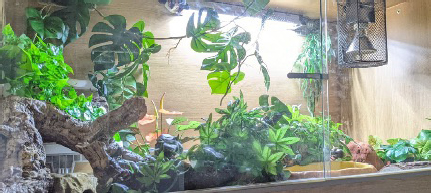
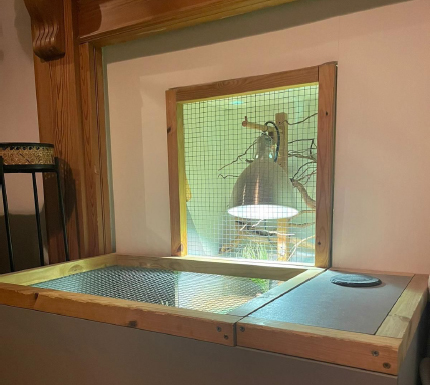
In general, animals from the order Squamata (lizards and snakes) are kept in vivariums, arboreal species are kept in taller enclosures and ground dwelling species have wider, shorter enclosures. Vivariums are ideal for species requiring higher environmental temperatures. Terrariums, sometimes used interchangeably with vivariums, are enclosures often made of glass and commonly used for more arboreal species and amphibians (Figure 3). However, these can make it harder to provide appropriate ventilation because of the many watertight seals and lack of vents. To manage this, close monitoring using hygrometers should be instated and mesh on the roof can aid with air flow. Finally, flexariums are similar in shape to terrariums but are made of mesh and allow for better ventilation – these are commonly used for chameleons.
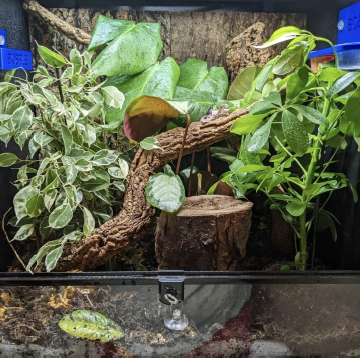
Chelonians are often split into three groups: tortoises, turtles and terrapins. Tortoises can be, but sadly often are not, kept in open-topped enclosures, termed tortoise tables. These are only appropriate up to a certain size of animal, after which a designated room or heated shed with access to outdoors during warmer times of the year is often required. Open-topped enclosures allow better ventilation, reducing the risk of respiratory disease (Hedley, 2014). Terrapins are commonly kept in fish tanks in which the water line is one-half to two-thirds the depth of the tank. Rocks or slopes extending proud of the water allow for basking. Many of these species are often bought as juveniles and hence very small. Owners should be made aware they may grow to be very large and require considerably larger tanks.
As with many exotic pets, clients are often unaware of what size enclosures are appropriate for their reptile. Recommendations have recently been published that summarise the appropriate enclosure sizes for the commonly encountered species, and owners can be directed to this document online (Federation of British Herpetologists, 2022), but it should be noted that these are minimum size guidelines and larger enclosures are to be encouraged if possible. Rack systems are commonly encountered housing in breeding facilities for snakes. Although these allow efficient use of space, they have limitations including limited size and ventilation. One study with royal pythons found that increased abnormal behaviours were seen more commonly in rack systems compared to more conventional enclosures; therefore, rack systems were not advocated from a welfare perspective (Hollandt et al, 2021). It is the authors opinion that the use of these should not be encouraged.
Substrate
Though commonly overlooked, substrate is an incredibly important aspect of husbandry, which can directly impact upon patients health (Rossi, 2019). An increasing number of substrates are available on the market. Substrate choice is dependent on multiple factors including species, the individual animal and the owner's preference. A temporary ‘safe’ choice for any species is newspaper as this can be easily changed, is low cost and is good option for a veterinary hospital. However, although rare, the risk of ingestion and subsequent obstruction is still possible. Owners often do not find newspaper aesthetically pleasing, and it does not allow natural behaviour or retain humidity so is not ideal for long-term use. For land-dwelling lizards and snakes, a variety of substrates can be considered, including coir, hemp, aspen, bark, reptile carpet and sand. Particle size is critical, as particles that are too small have an increased risk of ingestion and can ultimately cause gastrointestinal obstruction. Gravel and small stones are of particular concern (Rossi, 2019). Particle sizes that are either so small they could pass through the gastrointestinal tract unaided or large enough that the patient cannot eat it in the first place is ideal, although the practicalities of this can sometimes be challenging. Cautious use of such substrates should be encouraged, with feeding taking place outside of the enclosure or on a different surface, such as slate. For many tortoise species, topsoil can work well and allow for natural digging behaviour, especially females when preparing to lay (Wright and Raiti, 2019). With terrapins, particle size is still important and large rocks are often used to provide height for basking out of the water. Water itself can be considered a substrate for semi-aquatic patients. The water should be regularly checked to ensure it is the appropriate pH, salinity etc, and heating or cooling of the water may be required species dependent (Rossi, 2019).
Furniture
An animal's requirement to exhibit normal behaviour is one of the five freedoms and is protected by UK law (Animal Welfare Act, 2006). Part of this normal behaviour is the ability to hide. Ideally, two hides – one at the hot end of the enclosure and one at the cooler end – allow the animal to thermoregulate. Commercially available hides exist, but often sit on the ground. For more arboreal species, hides attached to the roof of the enclosure should be considered (Figure 4). Care should be taken to ensure the animal is not too close to the heat and ultraviolet sources. In addition, certain species such as the Asian water dragon (Physignathus cocincinus) would – in the wild – sit on branches overhanging water and jump into the water if they are scared. Hence, there is a risk of injury which should be mitigated by, for example, providing a deep enough pool of water to prevent trauma. This species also presents to veterinarians with abrasions to the rostrum caused by hitting the glass walls. Providing opaque visual barriers outside of the enclosure can help the animal know where the boarders of the enclosure are and avoid trauma. Hides can also be created through thick planting. This can be done using real or artificial plants and works well for species such as chameleons (Kubiak, 2021).
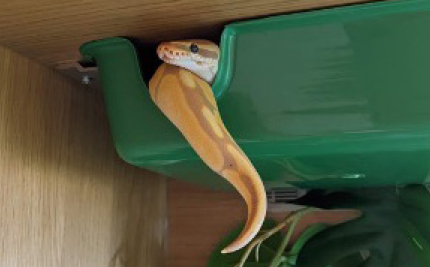
Mental enrichment is important for all pets. A study looking at 18 snakes of a variety of species noted a reduction in undesirable behaviour after novel items were placed in the enclosure, suggesting that enrichment is beneficial to welfare (Krishnan et al, 2022). A study looking at leopard geckos (Eublepharis macularius) found that enrichment which was thermal or food-orientated was more effective (Bashaw et al, 2016). For this reason, to mentally stimulate animals, making small changes within the enclosure every few weeks to months or the addition of novel items can be considered. The patient's stress level should be taken into account to ensure excessive stress is not caused.
Heat and lighting
All reptiles are ectotherms (McBride and Hernandez-Divers, 2004), meaning that they derive heat from an external heat source by behavioural means such as basking. For this reason, recreating what the sun provides is vital and composes of ultraviolet radiation, visible light and infrared radiation.
In terms of heat, each species has its own preferred optimal thermal zone. Multiple textbooks and papers detail these (Rizzo, 2014; Rossi, 2019; Varga, 2019; Liles and Di Girolamo, 2023) for species that are commonly kept as pets, but should these data not be available, asking ‘what do they encounter in the wild?’ is important. More uncommon species do not have a recorded preferred optimum thermal zone yet, so creating thermal gradients similar to their natural habitat is necessary. Heat can be provided in a multitude of ways including heat lamps, heat mats and reptile radiators. In the wild, heat is provided by the sun via infrared radiation (split into infrared A, B and C). Infrared A penetrates the skin and directly warms cells (Baines, 2017). Alternatively, infrared A may hit the ground and re-radiate into the longer wavelengths infrared B and C. These do not penetrate the epidermis; the warmth is instead absorbed with convection which carries the warmth deeper (Baines, 2017). For this reason, lamps such as tungsten and halogen lamps are preferred for basking areas. Heat mats and ceramic heaters should be used to manage background enclosure temperature and not basking areas (Baines and Cusack, 2019).
The heat source should be placed at one end of the enclosure and controlled by a thermostat. In addition to the thermostat, two separate digital minimum and maximum thermometers should be placed within the enclosure at either end to establish the thermal gradient. These are ideal as they record the lowest and highest temperatures the animal is experiencing throughout a 24-hour period – this negates the need for the owner to keep checking. Specifically during the night when the basking area is turned off and owner's home heating is also turned off, the room temperature may plummet. Using ceramic heaters or heat mats can mitigate this issue. Species have minimum cool temperatures (Table 1) and these should be followed.
Regarding visible light, many reptiles have full colour vision, including the ability to see ultraviolet A wavelengths (Baines, 2017). This is important for developing a circadian rhythm which can affect seasonal behaviour such as reproductive cycles (Baines and Cusack, 2019). Therefore, the provision of visible light is important and ideally should alter in length through winter and summer to imitate the wild.
Thermal gradients in enclosures have been discussed for some time. It is now becoming apparent that reptiles are in need of a light gradient. Frances Baines has produced a plethora of great summaries, and the reader is directed to UV Guide (2021) for further information. Creating handouts for owners and explaining husbandry, particularly covering heating and lighting, is beneficial to both owners and veterinarians. They allow the owner to understand this information in their own time and save valuable consult time. Use of diagrams also aids owner's understanding. In summary, ultraviolet light should be provided to all reptiles appropriate to species needs. It has many beneficial qualities, including mood enhancement, and it protects the skin barrier from irritants (Juzeniene and Moan, 2012). Ultraviolet B light with wavelengths of 290–315 mn specifically is important for Vitamin D3 conversion for calcium metabolism (Baines et al, 2016).
A variety of different bulbs exist including fluorescent tubes, compact fluorescent lamps, mercury vapor lamps and metal halides (Baines and Cusack, 2019). The Ferguson zone system has been created to aid in providing appropriate ultraviolet lighting. This system originates from a study in which 15 species of snakes and lizards were categorised into 4 zones depending on their ultraviolet exposure in the wild (Ferguson et al, 2010). Since then, additional species have been categorised accordingly, allowing veterinarians and owners to easily judge what ultraviolet requirements are needed.
The ultraviolet provision can be measured in the same way as temperature, with the use of a solar meter. Owners may not purchase these because of financial constraints. As ultraviolet bulbs wane in their output over time, a common practice is to replace the bulb every 6 months to ensure the output is still appropriate, though this can vary depending on the bulb used. As ultraviolet bulbs also emit visible light, there is often confusion if the bulb is working as it may be producing visible light but no longer emitting appropriate ultraviolet light; as such, measuring with a solar meter or regular changing of the bulb is important. In addition to ensuring the appropriate ultraviolet levels are provided and the bulb is changed frequently, the distance between the animal and bulb is important. If the bulb is too far away, it will not provide appropriate ultraviolet levels, and too close can cause pathology (Baines, 2017). Sometimes this can mean rigging up bespoke attachments for the bulbs to ensure the correct distance, and many companies sell equipment to allow this.
A common query raised when discussing ultraviolet light is what is appropriate for crepuscular and nocturnal species. Evidence supports that some of these species do bask but for shorter periods because their skin is able to absorb ultraviolet light more efficiently (Baines, 2017). Therefore, the question ‘what do they encounter in the wild?’ should be asked again. Research into this field is ongoing; a study looking at provision of ultraviolet light in leopard geckos found that 25-hydroxyvitamin D3 levels increased with only 2 hours exposure to ultraviolet light a day (Gould et al, 2018). In contrast, a study examining provision of ultraviolet light in royal pythons (Python regius) found no association between exposure to ultraviolet light and plasma 25-hydroxyvitamin D3 (Hedley and Eatwell, 2013). Despite this, as a result of the other benefits, it is generally accepted that ultraviolet light should be provided (Rizzo, 2014).
Heat, visible light and ultraviolet light can also cause pathology including photokeratoconjunctivitis and squamous cell carcinomas (Baines, 2017), so appropriate safety measures should always be adhered to. These may include bulb cages and measuring distances between the patients and ultraviolet bulbs. It is also important to note that placing any material between the bulb and animal will reduce the amount of ultraviolet light reaching the animal. Specifically formulated glasses and acrylics have now been created to reduce this issue, but there is still some reduction in ultraviolet light transmission (Baines et al, 2016).
Humidity
Humidity is provided either via manual misting or an automatic mister and is maintained by the enclosure's arrangement; for example, open-topped enclosures lower humidity, while enclosed setups maintain humidity. Humidity is measured with a hygrometer and many minimum and maximum thermometers often come with these inbuilt. One study looking at snake welfare in the UK found that nearly half of owners (48.1%) do not measure humidity (Cargill et al, 2022). As a rule, species from desert environments require lower humidity and species from tropical environments require higher humidity. Certain desert species do still require a confined area which is humid to aid with shedding. For example, the leopard gecko should have a humid hide offered. This can be easily created by cutting a small opening in a clean plastic box, layering the inside with sphagnum moss and spraying regularly. Certain species require very high humidity. In the authors’ opinion, manual misting alone is not sufficient to truly maintain these levels, so automated misters are required.
Water
Water provision depends on species and, again, veterinarians should ask ‘what do they encounter in the wild?’. Of course, aquatic species should always have access to water but may be ‘dry docked’ when medical treatment is needed. Some species may not eat during this time so limited access to water should be provided if feasible. For terrestrial species, a water bowl ideally as large as the patient allows for both drinking but also bathing. Ensuring the water is not deep enough for a patient to drown is important and the water should be changed daily. Certain species, for example most chameleon species, may prefer to drink from water dripping from foliage. Certain reptiles, such as tortoises, have the capacity to absorb water via their cloaca and so can rehydrate efficiently through bathing (Herrin, 2017).
Need a friend?
Again, asking the question ‘what do they encounter in the wild?’ can be helpful here. Some species live in small groups, while some are solitary except during the mating season. In general, it is acceptable to keep individuals separate, but if the owner is keeping these animals in groups then they must ensure appropriate space and resources are provided and species are not mixed, especially when from different areas of the world. Keeping reptiles alone is particularly important for certain species whose normal diet can involve other reptiles, for example kingsnakes (Lampropeltis spp.).
Bioactive set ups
Bioactive set ups are becoming increasingly common, but discussing these fully is outside the scope of this paper. The general concept is an enclosure which is often, at least in part, self-sustaining with ‘custodians’, invertebrates which live within the enclosure and remove waste products (Figure 5) (Abou-Zahr and Calvo Carrasco, 2019).
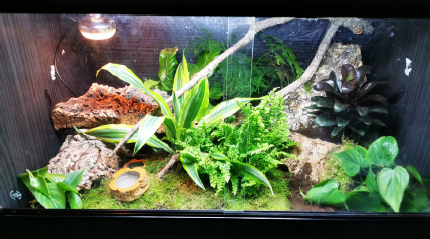
Conclusions
Providing appropriate environment for a patient is protected by the law in the UK. Simply having an ultraviolet light and heat mat present is not enough. It is important for veterinary teams to be aware of what their reptilian patients need in order to provide guidance to owners, ultimately improving animal welfare. Many unknowns still exist in this field. More study in this area of herpetology is needed, looking at wild individuals and recording their natural environment so vets and owners can continue to improve what can be offered in captivity.


